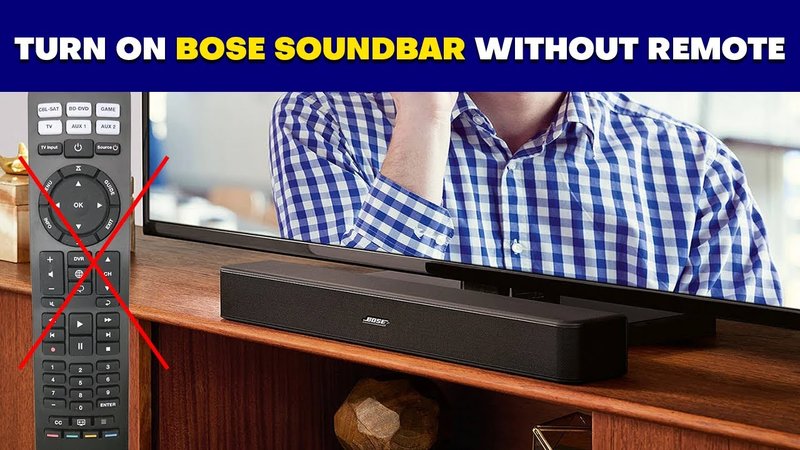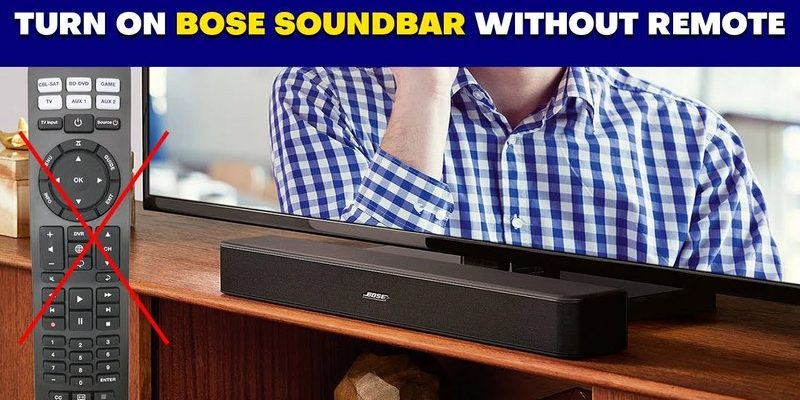
Let’s get straight to it: Bose makes beautiful soundbars, but their remotes can be a little mysterious. They often look sleek and simple, but the programming part? Well, that can feel like trying to crack a secret code. But what if you don’t have that trusty booklet with all the magic numbers and steps? Is there a way to sync up your remote, reset its settings, or pair it to your devices without resorting to the official instructions? Let me walk you through it, as if we’re figuring this out together.
How Bose Soundbar Remotes Typically Work
Here’s the thing: Bose soundbar remotes (especially the universal ones) are made to talk to more than just your soundbar. They can control your TV, Blu-ray player, and a bunch of other gadgets — if you know how to program them. Usually, programming means entering special codes, holding certain buttons, and waiting for that magical moment when everything connects.
But what happens when the manual — with all those codes and step-by-step guides — is gone? First, it’s good to know that Bose remotes aren’t all built the same. Some are simple, with basic volume and power; others are “universal” models with more buttons than a spaceship console. The universal versions need to be told what device you’re trying to control, and they use something called a device code to do this.
If you’re holding a remote that just has power, volume, and mute, there may not be any programming at all. But for those with extra buttons for TV, AUX, or CBL-SAT, programming is definitely in your future (manual or not). Understanding how these remotes “talk” to devices helps you troubleshoot, reset, or pair without feeling totally lost.
Programming Without The Manual: Is It Really Possible?
It’s a bit like trying to assemble IKEA furniture without the little booklet — possible, but you might end up with a shelf that wobbles. Still, Bose remotes can almost always be programmed without the paper manual, as long as you’re patient and willing to experiment. Here’s what you need: the remote, some curiosity, and maybe your smartphone for googling model numbers or finding codes.
Most Bose remotes use a set of “universal” codes. And the good news? These codes aren’t locked away in the manual; they’re all over the internet. Bose support sites and forums have searchable lists. If you know your TV or device’s brand, you can usually find the right code with a quick search. Even better, some newer Bose soundbar remotes can “learn” commands by copying them directly from your device’s remote — no code required!
But, and this is important, the process can take a few tries. If you’re cycling through codes, expect some trial and error. Sometimes your remote will blink, beep, or do nothing at all. Don’t panic — that’s totally normal. As for reset and pairing, more on that in a moment.
How To Find The Right Device Codes Online
You might be thinking, “But where do I actually get these codes?” It’s not as mysterious as it sounds. Start by flipping over your Bose remote and looking for a model number (example: RC-PWS III or RC-22). Jot that down. Then, head to the Bose website or just punch “Bose soundbar remote codes” + your TV brand into Google. There are dozens of legitimate sites that host these codes, pulled straight from the official Bose manual.
- Visit support.bose.com: Enter your soundbar model and remote type.
- Search for your TV or device’s brand in the code list.
- Try the codes one at a time — some brands have multiple possible codes.
Pro tip: Sometimes the codes are three digits, sometimes four. If the first code doesn’t work, keep going down the list. I’ve spent an entire afternoon finding the right code for a stubborn old TV, but hey — it finally worked.
If your remote can be put into “programming mode” (usually by holding a special button), you’ll know you’re on the right track when an LED light starts blinking. That’s your remote’s way of telling you, “Okay, I’m ready. Give me a code.” Enter it, and watch for a confirmation blink or flash.
Manual-Free Programming: Step-By-Step
So, let’s paint a picture. You’ve found the right code online and you’re ready to program. Here’s a common process for Bose universal remotes (your steps might differ slightly by model):
- Hold the device button (like “TV” or “CBL-SAT”) on your remote until the LED light turns on.
- While holding that button, enter the device code you found online.
- Release the button and see if the LED flashes (usually means “success!”).
- Test the remote by pressing power, volume, and input. If it works, you’re golden.
- If not, repeat the steps with the next code in the list.
Don’t worry if you don’t nail it the first time. I once went through six codes to get my soundbar to finally listen — patience (and maybe some coffee) helps.
Some remotes also offer an “auto-search” method, where you hold down a button and the remote cycles through every possible code until your device responds. If you see your TV turn off or the volume jump, that’s your cue to stop and save the code. No manual necessary, just a little bit of persistence.
Using The Remote’s Learning Mode
Here’s where Bose gets a little fancy. Some of their newer soundbar remotes come with a “learning” feature. Instead of punching in codes, the Bose remote can “learn” commands directly from another device’s remote.
- Find the “learn” or “setup” button (usually tiny and tucked away with a pinhole).
- Hold it until the LED blinks.
- Point your device’s remote at the Bose remote and press the button you want it to copy (like “Power” or “Volume”).
- The Bose remote blinks to confirm it’s learned the command.
This trick is great if your device isn’t showing up in any code lists, or if you just want to make your remote do something special. It’s also handy if your remote loses sync or you swap out devices.
If you ever get stuck, resetting your remote (pulling the battery or pressing a tiny reset button) often clears up most issues. Kind of like turning your phone off and on — it’s the IT solution for everything, even remotes.
Resetting And Syncing If You Hit A Wall
Let me be honest: sometimes, even after you’ve tried every code and method, your remote just refuses to play along. Maybe it’s lost sync with your soundbar, or maybe there’s a bug from a battery swap. Here’s how to reset and re-sync, manual-free.
Most Bose remotes can be reset by removing the batteries, waiting a minute, and popping them back in. Some have a special reset button hidden inside the battery compartment. After a reset, you’ll usually need to reprogram your remote using the steps above, but it helps clear out any bugs or glitches.
If your remote and soundbar won’t “pair” — meaning, they’re not talking to each other — try these steps:
- Turn off your soundbar.
- Press and hold the Bluetooth or “pair” button on the remote (check for a Bluetooth or sync symbol).
- Wait for the soundbar to flash or beep, indicating it’s paired.
If nothing works, double-check that your batteries are fresh. You’d be surprised how many times a weak battery messes things up. Swap them out and try again before you toss the remote across the room.
Universal Remotes vs. Official Bose Remotes
Here’s a fun fact: you don’t have to stick with the Bose remote if it’s being too stubborn. There are plenty of universal remotes out there that can control Bose soundbars — sometimes even more easily than the official one. These universal options come loaded with most major brand codes or offer guided set-up through a phone app.
- Bose universal remote: Looks nice, works seamlessly with the soundbar, but needs extra steps to control TVs and other devices if you’ve lost the manual.
- Third-party universal remote: Often more user-friendly, with a code search feature or even voice control. Can control multiple devices in one place (TV, soundbar, streaming stick, etc.).
Just make sure the universal remote explicitly supports Bose soundbars, and check customer reviews for the pairing process. If you’re using a universal remote, the code entry process is almost identical to Bose’s own: find the code, enter it, then test every button you care about.
Sometimes, a universal remote actually saves the day when the original goes missing or stops working. It’s like having a backup quarterback — not always the first choice, but super clutch in a pinch.
Troubleshooting Common Issues (And When To Ask For Help)
So what if you’ve tried programming, syncing, learning mode, and even a different remote, but the soundbar still won’t budge? There could be a few reasons:
- Batteries are weak or upside-down (don’t laugh — it happens more than you’d think).
- The remote’s IR (infrared) beam is blocked, dirty, or broken. Try cleaning the front of the remote and the soundbar’s sensor with a soft cloth.
- You’re using the wrong code. Double-check the model, device brand, and code list. Sometimes, there are multiple “series” within a brand.
- The remote has a hardware fault, especially if it won’t turn on even with new batteries. In this case, a replacement might be in order.
If you’re stuck, Bose customer support isn’t as scary as it sounds. Their chat and phone teams can usually walk you through programming without a manual, or point you to a digital PDF copy in seconds.
A Few Final Thoughts On Manual-Free Remote Programming
Honestly, not having the manual is a little annoying, but it’s definitely not a dead end. Bose soundbar remotes are designed to be user-friendly (with a few quirks), and the world of online support, device codes, and learning modes means you can almost always get things working again. Think of it like solving a puzzle — sometimes it takes a few tries, but the pieces eventually fit.
Just remember: go step by step, don’t panic when it doesn’t work the first time, and don’t be afraid to try alternative remotes if all else fails. Most importantly, enjoy the moment your soundbar finally obeys — because nothing beats hearing your favorite playlist or movie with rich Bose sound, all from a remote you programmed yourself (no manual required).
So, next time you find yourself clutching that mysterious Bose remote, manual long gone, take a breath. It’s doable, you’ve got options, and hey — you might even impress your friends with your newfound tech wizardry.
